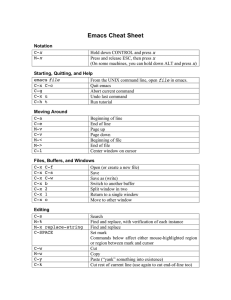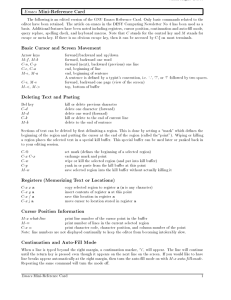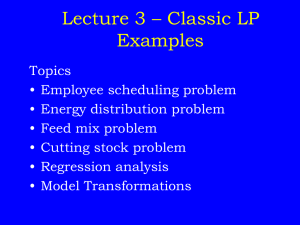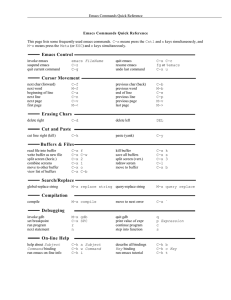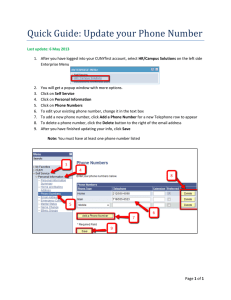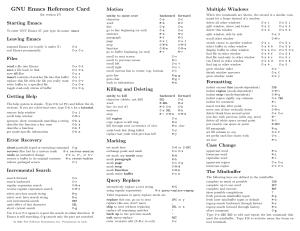Emacs command cheat sheet
advertisement
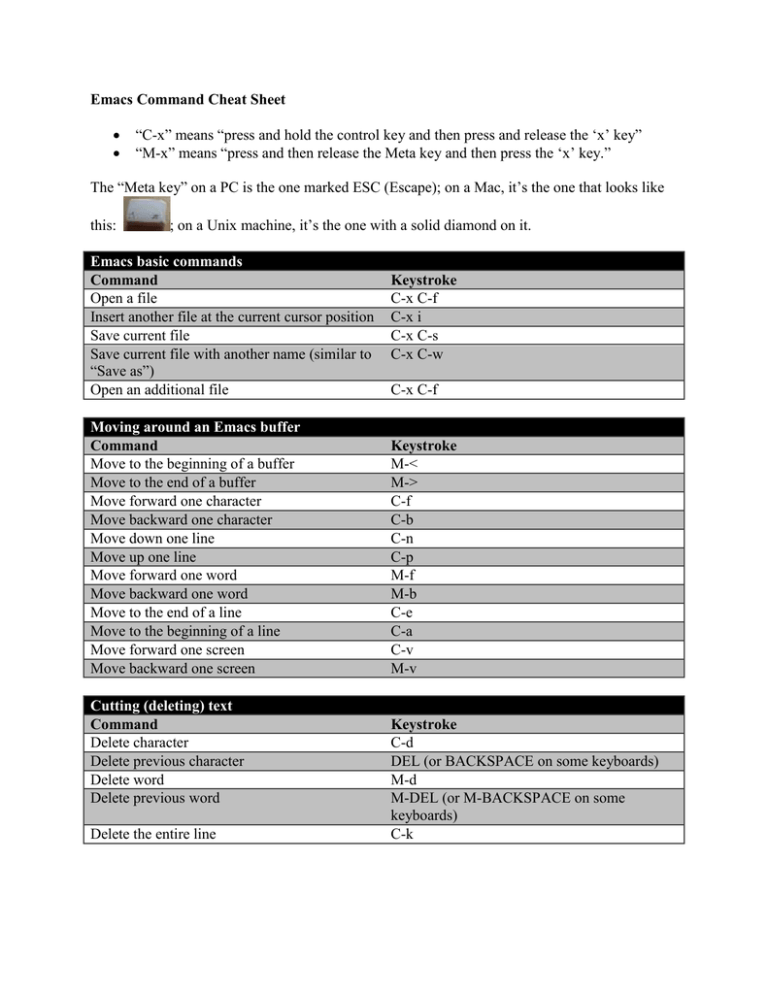
Emacs Command Cheat Sheet “C-x” means “press and hold the control key and then press and release the ‘x’ key” “M-x” means “press and then release the Meta key and then press the ‘x’ key.” The “Meta key” on a PC is the one marked ESC (Escape); on a Mac, it’s the one that looks like this: ; on a Unix machine, it’s the one with a solid diamond on it. Emacs basic commands Command Open a file Insert another file at the current cursor position Save current file Save current file with another name (similar to “Save as”) Open an additional file Moving around an Emacs buffer Command Move to the beginning of a buffer Move to the end of a buffer Move forward one character Move backward one character Move down one line Move up one line Move forward one word Move backward one word Move to the end of a line Move to the beginning of a line Move forward one screen Move backward one screen Cutting (deleting) text Command Delete character Delete previous character Delete word Delete previous word Delete the entire line Keystroke C-x C-f C-x i C-x C-s C-x C-w C-x C-f Keystroke M-< M-> C-f C-b C-n C-p M-f M-b C-e C-a C-v M-v Keystroke C-d DEL (or BACKSPACE on some keyboards) M-d M-DEL (or M-BACKSPACE on some keyboards) C-k 2 Marking text to delete, move, or copy Command Mark the beginning of a selection Delete the marked region Copy a marked region Paste (Yank) a cut or copied region Searching & replacing text Command Incremental search forward Incremental search backward Exit incremental search Cancel incremental search (or just about any other command) Delete incorrect character in search string of incremental search Non-incremental search forward Non-incremental search backward Start query replace Replace current instance and continue on to next instance Don’t replace current instance, but move on to next instance Replace the current instance and then quit Replace the current instance and then pause Resume after pausing Replace remaining instances without asking Back up to previous instance Exit query replace Search for a group of sequential characters forward Search for a group of sequential characters backward Search for a group of sequential characters forward and incrementally Search for a group of sequential characters backward and incrementally Keystroke C-@ or C-SPACEBAR C-w M-w or C-INSERT C-y Keystroke C-s C-r <ENTER> or <RETURN> C-g DEL (or M-BACKSPACE on some keyboards) C-s RETURN (or ENTER on some keyboards) C-r RETURN (or ENTER on some keyboards) M-% SPACEBAR or y DEL (or M-BACKSPACE on some keyboards) or n . (period key) , (comma key) SPACEBAR or y ! ^ RETURN (or ENTER on some keyboards) or q M C-s RETURN (ENTER on some keyboards) FOLLOWED by thisIsMySearchExpressio* M C-r RETURN (ENTER on some keyboards) FOLLOWED by thisIsMySearchExpressio* M C-s M C-r 3 Moving among buffers Command Move to the previous buffer Display buffer list Delete current buffer Create two windows Move to the other window Delete the current window Delete all other windows except the current one Various other commands Command Undoing recent changes Undo all changes since the last save Go back to an earlier version of the current file (the file as it appeared when you first opened it) Pop out to your Unix prompt Cancel current command Keystroke C-x b C-x C-b C-x k C-x 2 C-x o C-x O C-x 1 Keystroke C-x u M-x revert-buffer C-x C-f filename~ RETURN (RETURN ON SOME keyboards) FOLLOWED BY C-x C-w filename C-z C-g This document was adapted from a larger document that can be found at http://cs.iupui.edu/~kweimer/EmacsCheatSheet.pdf. Unfortunately, I’ve been unable to figure out who produced the original document.
